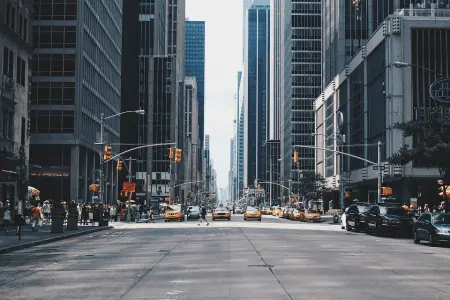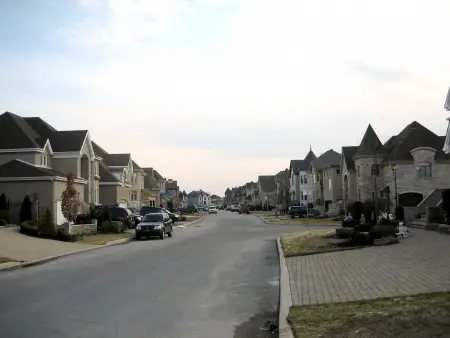Human settlements have come a long way. Long ago, people used to establish small communities around clean water sources and in areas where they could hunt or grow food. The choices we have today for where and how we live are considerably more varied and more complex. Therefore, depending on the type of life you wish to live, you have plenty of options. Let’s find out what defines the urban, suburban, and rural environments.
Summary Table
| Urban | Suburban | Rural |
| A human settlement with high population density | A form of urban settlement with medium population density | A human settlement with a low population density |
| Exclusively man-made environment | A combination of built areas and green spaces | Mainly a natural environment |
| Has paved roads, a business center, and facilities as diverse as the population and its needs | Has paved roads and it is only a residential area | Sometimes has dirt roads that connect neighboring properties |
| Offers numerous employment options | Offers access to city jobs through commute as well as some local jobs | Has limited job opportunities as most people live off the land |
| Thrives on business development | Thrives on peoples’ need for better living conditions | Thrives on agriculture |
| Can be crowded, noisy, and dirty | Seen as the middle ground between city and country life | Can be isolated, underdeveloped, and offer few opportunities apart from agricultural work |
Definitions

An urban area is a type of settlement with a very high population density. Although we tend to associate only cities with the term, it can also define towns and suburbs.
The urban environment is man-made. There is an extensive infrastructure that makes the settlement’s backbone, consisting of paved roads, living units, business centers, learning centers, places of worship, and leisure centers. The bigger the population, the more the infrastructure needs to grow.
According to data collected in 2014, 3.9 billion of the 7 billion people in the world live in urban areas. Thus, there is constant interest in developing this type of community. And while there are hundreds of cities in the world, they all vary considerably as it all depends on their historical contexts. Some may have experienced a considerable growth in the past and people may still be living in old houses of historical importance while having all the advantages of modern life. Others may have known growth in the industrial era and have extensive industrial urban neighborhoods designed for many people of lower income living in apartment buildings. And there are those that have experienced growth in the modern day and have new residential units and modern business centers. In most cases, a city is a combination of all of the above.

A suburban area, or a suburb, is mainly a residential area connected to a large city. It is usually located on the outskirts of the city, within driving distance for the people who commute to work. In some cases, the suburban area has developed in an existing part of a city with fewer points of common interest.
With one-family living units in suburban areas, there is a lower population density. Therefore, with some streets being used only by residents to drive to and from home and without points of common interest in many areas, traffic is light and the areas are less polluted. People living in the suburbs commute to work in the city. And although they may not have theaters, museums, and other institutions you might find in the city, there are kindergartens, schools, supermarkets, gyms, and other services considered necessary to have in a relative vicinity of your house.
These communities were born from the need to lead both a peaceful life at home yet still have access to the perks of the big city.

A rural area, or a countryside, is located away from crowded communities. The environment is mainly natural, with few constructed infrastructures, sometimes dirt roads, and very few facilities. People in rural areas can either live on farms or in villages. Agricultural areas and forests are considered rural areas.
Depending on the village, it can have the bare necessities such as a school, a religious center, a post office, a police station, a community center, or a store. A settlement can have all or none of these facilities. And while most people live off their land and need little from the outside world in rural areas, they travel to the closest town for the things they do need.
Urban vs Suburban vs Rural
So what is the difference between urban, suburban, and rural?
All of them are forms of settlement and they define the way in which the area developed. The urban area is the most crowded. It represents a man-built environment, with buildings and paved ways. Everything a person needs can be found in a store and all possible services are offered by specialized firms. Business drives a city and contributes to its development. Suburban areas are also man-built, although there is more consideration for peace and quiet and the constructions in such a settlement and they are not as crowded.
There is access to city facilities but from a considerable distance. Therefore, while living in a big city you can get Ethiopian food delivered at 3 AM, it is difficult to do so from the suburbs. On the other hand, people living in the suburbs have access to the city institutions that are only a car or train ride away.
In rural areas, the environment is mainly natural. The urban and suburban paved roads are replaced by dirt roads, and the business and facilities of city life are replaced by what a person can produce for himself/herself. As far as facilities go, rural areas either have the bare necessities or people must travel to the closest town for them.
As far as crowding is concerned, urban areas are the most crowded, with several families living in the same apartment building. A suburban area means numerous one-family units, whereas a rural area can also mean a secluded family farm at a great distance from the closest neighbor.
Life in urban areas can be stressful. Life in the suburbs is supposed to be peaceful, while life in the countryside can be both peaceful and stressful as working the land and raising animals are not easy jobs.
Urban life offers access to more job and career opportunities, while people in the suburbs commute to their city jobs. People in rural areas, on the other hand, have little chance of local employment as there are very few institutions around. They can either work in town or work their own land.
The suburbs is seen as the best mid-way solution. It has the perks of both worlds: peace and quiet and a more natural environment, as well as access to jobs and other urban facilities. For some, city life can be too extreme, too crowded, too noisy, and too polluted. On the other hand, country life can seem too monotonous, dull, or difficult for someone who is not accustomed to living off the land and having few outside resources.
Americans and Western Europeans tend to view Suburban areas as extensions of their own urban centers. While this is true, it also is not entirely accurate. The majority of Suburban communities are comprised of family homes and neighborhoods that are set apart from the rest of the city. These neighborhoods, which are generally found in cities, suburbs and towns that are less densely populated than their urban counterparts, provide their residents with all of the amenities of a modern lifestyle, while being far enough away from the hustle and bustle of the city to allow for greater freedom and quiet.
Metropolitan areas like New York City, Los Angeles, and Washington D.C. are examples of what a modern city can be like. However, suburban communities have become an integral part of the American way of life. Most cities have suburbs that surround them and these suburbs have a population of at least 10,000 people or more. Manhattan and other metro area in New York state (300.46 square miles) have an older population, while many suburban communities are growing and diversifying. In addition, Phoenix is an example of a city that is a mix of the Suburban and Urban communities. It is located in the Southwest part of the United States.
The area was first settled by Native Americans and was known as the Hohokam Pueblo. The area was populated by many different tribes and they all had their own lands
The cost of living in an urban area is usually lower than that of a suburban area. A home in a suburb can cost anywhere from $200,000 to $300,000. A home in an urban area will cost around $100,000 to $150,000. In an urban area, public transportation and public transit is more convenient, and there are many more restaurants, shops, and other businesses.
San Francisco, which is an example of a suburban community, has developed over the years into a beautiful city. It has grown to encompass a metropolitan area of more than 4 million people. The cities provide their suburbs with financial support and infrastructure; while the suburbia provide the cities with services such as entertainment and shopping.
Suburban Living and Urban Communities
Suburban communities are found in all parts of the country, in every type of climate and in every kind of landscape. They range from small villages where people grow their own food to cities where children walk to school along tree-lined streets that surround perfectly manicured lawns and well-kept homes.
The demographic data and the number of people living in the Suburban community varies from region to region. For example, there are many communities in which a majority of the population is African American. The South has many communities where the predominant race is Hispanic. While it is important to note that these areas have their own distinctive characteristics, they are all suburban communities in one way or another.
Single-family housing is the most common type of housing in Suburban communities. The majority of homes are single-family detached dwellings, but there are also single-family homes with attached dwellings, multifamily dwellings and apartments.
The housing may be large or small.
Real estates are purchased and sold in the Suburban residents in the same way as they are in any other part of the country.
There are a number of different types of houses that are available for sale, ranging from houses that have been converted into apartments to very large houses.
Although most people live in Suburban communities, there are also many communities where many people commute to work every day. This is often because these areas are located near major cities, central cities or the city center, or universities. There are also areas where people work at different jobs and then come home to their families.
The quality of life for the Suburban community also varies widely. Some of the most affluent communities are found in upscale areas like New York City and Beverly Hills. However, some of the poorest areas can be found in the Midwest, where families live in small houses on plots of land they can only afford to cultivate with what they can grow themselves. Millennials make up the largest demographic group in the Suburban community.
Rural communities, on the other hand, are different from their urban counterparts. In the Suburban community, there is an ever-present sense of family and a community that is centered around work and school.
In the rural areas, families usually spend more time working in the fields or tending to livestock.
Small towns, which are generally located in rural areas, also have a suburban character. They tend to be home to large agricultural and industrial businesses, as well as many small farms.





